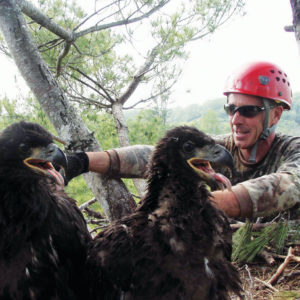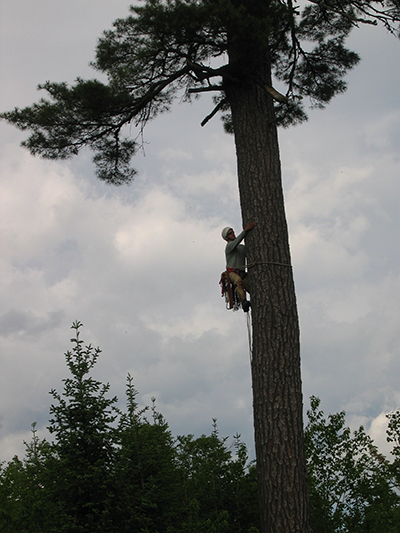BRI Studies: Capture Techniques
Much of BRI’s research depends on working hands-on with wildlife in the field. We capture and handle wildlife for a variety of scientific purposes: to collect blood and tissue samples for toxicology assessments; to apply bands and tracking equipment; and to study behavior, population trends, and movements.
BRI researchers are well versed in the humane capture, handling, and release of a broad range of species including (but not limited to): an extensive array of birds; bats including species recently listed as endangered; and furbearing mammals such as otter, mink, muskrat, and beaver. BRI biologists utilize specific skills to achieve successful captures, such as scaling 90-foot trees to reach eagle nests, rappelling down cliff ledges for adult peregrine falcon capture, and installing floating mist nests for waterbirds.
Capture and Handling Procedures

The work of successful capture starts long before our biologists reach the field. The study of wild animals in natural settings, including captures, is controlled in many ways, necessitating a full understanding of the relevant rules and regulations. BRI maintains all state and federal permits necessary for handling wildlife.
BRI biologists maintain a strong adherence to protocols that ensure the welfare of the animals we study. Successful captures require ingenuity and skill. Our biologists rely on a broad range of traditional capture techniques and develop new methods specific to the ecosystem or habitat of the study species.
Continuing to Stretch Boundaries

The application of advanced technologies is a hallmark of BRI’s innovative wildlife science. BRI’s scientists not only use state-of-the-art technology and field methods but also develop new methods to enhance our fieldwork and improve our data analysis.
For example, our wildlife biologists have perfected nighttime loon capture techniques. These methods proved inadequate in the Arctic, and in response, field crews developed site specific methodology that allowed the capture of loons during the long daylight hours in the region.





